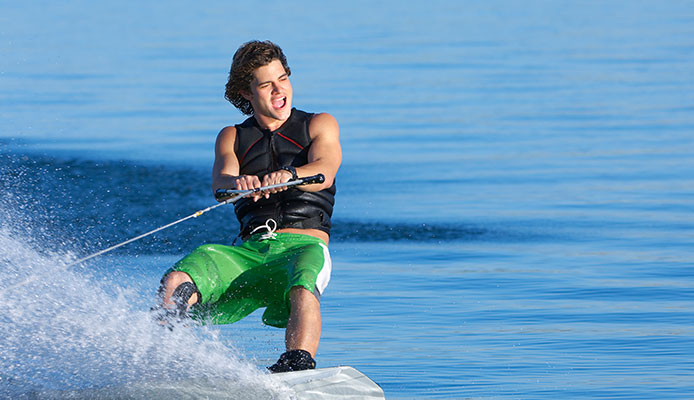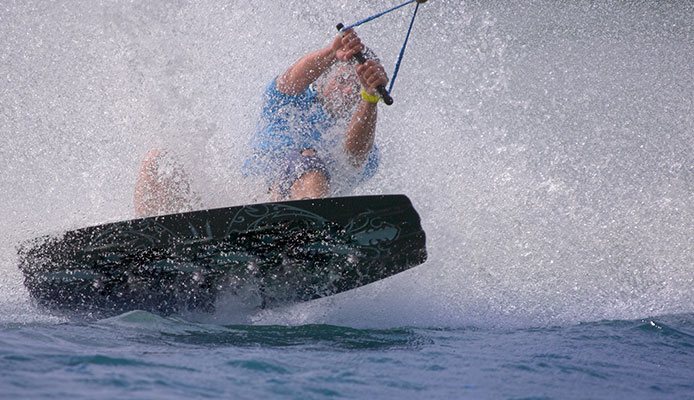
The allure of popping an ultra-stylish tail grab or catching tons of air is enough to make anyone want to get started with wakeboarding. However, before you can get your pilot wings and enjoy some impressive hang time when jumping wakes, you need to learn the basics.
Getting up on a wakeboard is one of the most important first lessons. Focusing on showing you wakeboarding how to get up, this detailed guide will make wakeboarding feel less intimidating.
Wakeboarding How to Get Up Guide
1. Put on a Life Jacket
Even if you are good at swimming, you should wear a wakeboard life jacket or vest when wakeboarding. In addition to helping you avoid drowning, the life jacket will keep you floating as you wait for the boat to pull you up.
2. Learn Communication Hand Signals
Before getting in the water, familiarize yourself with the hand signals you can use to communicate with the boat’s driver. For example, the thumbs-up signal tells the driver to speed up while thumbs down means reduce the speed. A slash across the neck means to cut the motor or stop the boat.
3. Adjust the Wakeboard Bindings
Set the bindings on your wakeboard so they feel both secure and comfortable. If the bindings are too loose, it will be impossible to maintain balance in the water. If they are too tight, your feet will hurt, taking all the fun out of the sport and making getting up on a wakeboard overly stressful.
4. Get in the Water
When looking for a boat to use when learning wakeboarding how to get up, look for one with a wakeboard tower. If you are using your boat, installing a wakeboard tower can make your learning process much easier.
Once you are out on your chosen wakeboarding spot, keep 1 hand on your rope’s handle as you scoot off the boat’s stern into the water. Take a couple of minutes to get comfortable, sitting in the water, as your boat starts to move away. Once the rope is taut enough, use it to maintain balance while you float in the water.
Be sure to maintain a good grip on your rope’s handle so that it does not fly out of your hands. While doing this, keep your arms relaxed and the knees bent while floating in the water.
5. Keep the Wakeboard on Its Edge
Starting, ensure that the wakeboard is positioned on its edge – the board’s bottom should be perpendicular to the water surface. Also, keep the board slightly above the water surface.
Note: Trying to keep your board flat underneath you makes it impossible for you to balance when your boat accelerates.
6. Put One Arm on Either Side of the Front Knee
Before you put on your board shorts and rash guards for your wakeboarding expedition, it is crucial that figure out which foot to put forward. You should do this by having a friend push you from behind – the foot that steps forward first will be the one to put forward on your wakeboard. Next, with arms bent, bring the rope’s handle close to your chest.
7. Stay As Close As Possible to the Board
To get close enough to the board, you will need to bend both knees as far as you can. Staying close to the wakeboard makes it much easier for you to get into the upright position. As your boat starts to accelerate, keep the knees bent and the ankles close to the body in a horizontal squatting position.
8. Let the Boat Lift You
When trying to figure out wakeboarding how to get up for the first time, most people make the mistake of trying to lift themselves. Trying to muscle your way up puts you at the risk of losing balance and faceplanting.
The best thing to do when getting up on a wakeboard is to let the boat do all the work. Allow the boat to lift your board onto the water surface. Avoid bending your arms to bring the rope’s handle closer to the torso. Also, do not pull back against the boat’s force as it picks up speed.
9. Transfer Weight to Your Forward Foot
To get up on the wakeboard, you will need to keep more than 60% of your body weight forward. Once you have gotten up on the wakeboard, you can distribute your body weight evenly on both feet to stay balanced on your board.
To gain more control when getting up, keep your rope low and near the front hip. Raising the rope can unbalance you, making it harder to stay on your wakeboard. Grip your handle firmly and keep both elbows bent.
10. Stand Up Slowly
Once the boat’s force pops your wakeboard on top of the water, start straightening your legs, keeping both knees slightly bent to absorb some of the impacts. Point the forward hip toward the handle on your tow-rope.
After getting up on a wakeboard successfully, get the feel for the wake by slightly leaning back to shift your body weight to the heels. This will help set the board heelside on the back edge.
Next, practice leaning forward to shift the weight to your toes to set the wakeboard toeside on its front edge. This will allow you to maneuver and cut forth and back across the water.
If you fall or let go of the rope accidentally, simply stay where you are. Lift the wakeboard halfway out of the water to make you visible to other boats in the area. Your boat driver should turn around to bring you the rope so that you can give the process another go.
Tips for Getting Up on a Wakeboard

1. Shorten Your Rope
If you are putting on your wakeboard helmet for one of your first wakeboarding sessions, you may have more success with a shorter wakeboarding rope. Use a rope that is approximately 20 feet long.
Note: Typically, ropes used for wakeboarding feature a length of between 30 and 50 feet.
2. Reduce the Boat Speed
While some wakeboarders think that going full-throttle gives them enough momentum to get up, it makes the whole process more difficult. After removing your board from the wakeboard rack, inform your driver to keep the boat speed under 16 miles per hour to make it much easier for you to get up.
3. Switch Your Feet
If you are having trouble getting up on a wakeboard, you can try solving your problem by simply reversing your feet’s position. For example, if you have been trying to get up with your right foot forward, try getting up with your left foot forward.
4. Invest in a Wakeboard Tower
While you can wakeboard without a tower, you may end up facing some problems. For example, when the rope is attached at a lower point, the turbulence created by the boat can disturb it, making it harder for you to maintain balance. Also, a low rope often forces the wakeboarders to look down, checking for its clearance – this ends up destabilizing them.
Creating a higher towing point, a wakeboard tower improves stability and also pulls you up, making it much easier for you to get up. In addition to all these benefits, you can attach wakeboard tower speakers to make your learning experience more enjoyable.
5. Lean Back Carefully
A common mistake often made by beginning wakeboarders is leaning too far forward. Doing this can put the board’s tip underwater, making you lose balance and faceplant. Leaning back lets you stay up after successfully getting up.
Experts often recommend placing the back binding close to the back of the wakeboard – this will position it over your back fin. This should put your weight on the back fin when you lean back, making it much easier for you to control the board.
6. Use Gentle Movements Only
On a wakeboard, any sudden movement can make you lose balance and fall. The key to staying on your board is to make slow and gentle movements at first as you focus on getting your bearings. Once you start going, soften both knees, keep them bent slightly and guide the front of your board toward the back of the towing boat.
7. Avoid Jerky Boat Movements
While going slow is key, it is not the only thing that counts when it comes to helping you get up without falling. More often than not, jerky movements will send you in the water face first. For this reason, if your boat driver has to increase or decrease the boat speed, ensure that he/she is doing it gradually.
Globo Surf Overview
When it comes to wakeboarding, getting up on a wakeboard is the first piece of the puzzle. If you can’t get up, you can’t proceed to do other exhilarating stunts such as jumping over wakes. This detailed article teaches you wakeboarding how to get up. We have also outlined some tips you can use to make your time easier when getting up.
More Tow Reviews:
- Waterproof Fitbit
- Inflatable Boat
- Surf Watches
- Rash Guard
- Surfing Ear Plugs
- Wakeboarding Vs Wakeskating
- Wakeboarding Without A Tower
- Wakeboarding Vs Kitesurfing
- Kitesurfing Equipment
- Kiteboarding Spots

